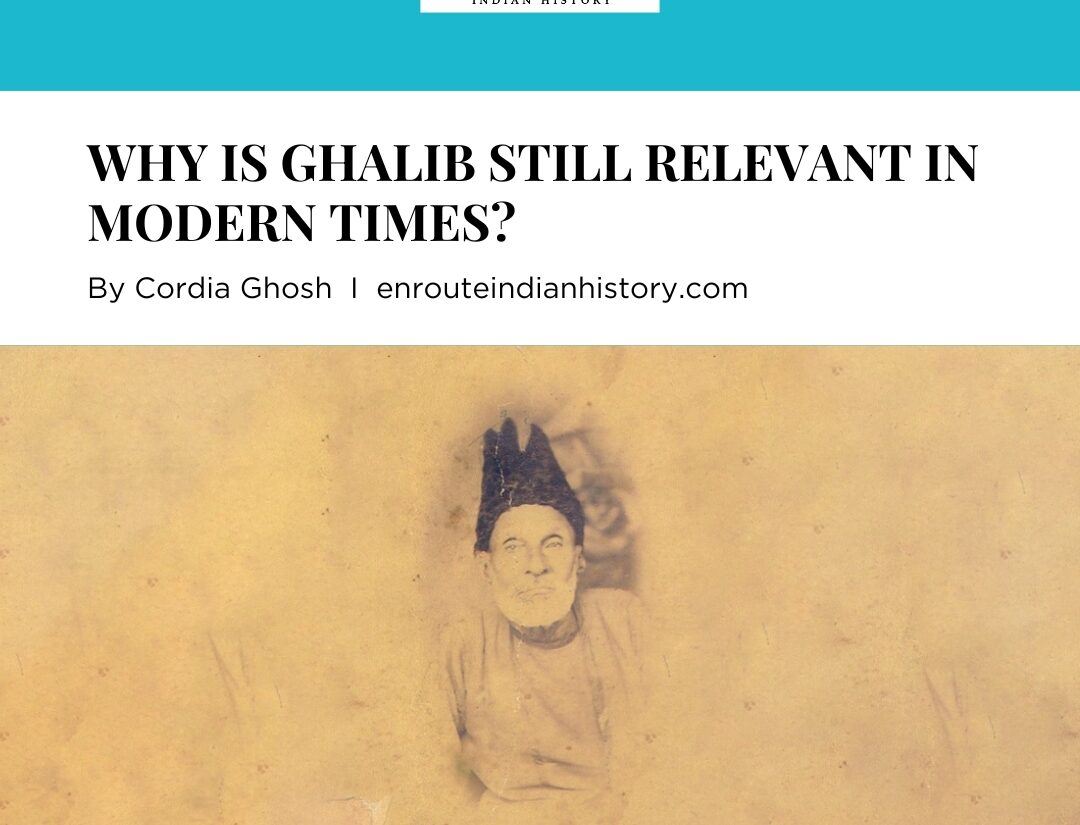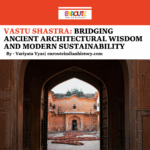
Ghalib’s Enduring Relevance in Contemporary Delhi.

Source: wikimedia commons Mirza Ghalib 1969 stamp of India
Hoga koi aisa bhi ki Ghalib ko na jaane
Shaayar to vo achha hai pe badnaam bohot hai
(Would there be anyone who wouldn’t know of Ghalib?
He is a good poet, but also just as notorious.)
Like all geniuses, Ghalib is a mystery.
GHALIB
Mirza Asadullah Khan Ghalib, the quintessential metaphor for Delhi, transcends his name beyond the boundaries of time, culture, and geography to embody the essence of the poetic soul. Ghalib’s legacy in modern Delhi, from the late 18th century through the 19th, 20th, and 21st centuries, resonates profoundly, remaining relevant in contemporary India and Pakistan. His modern adaptation, characterized by a nuanced exploration of human emotions and existential questions, resonates deeply in contemporary literary circles. Ghalib’s relevance in urban Delhi is evident in the way his poetry captures the city’s ethos, reflecting its cultural richness and historical depth, making him a timeless icon in the world of Urdu poetry.
Poochhte hain vo ki Ghalib kaun hai
Koi batlaao ke hum batlaaein kya
(They ask, ‘Who is Ghalib?’
Someone tell us what we should say!)
Ghalib, renowned for his enduring legacy in modern Delhi, emerges as a spiritualist who initially celebrates God’s visible presence before delving into the necessity of His omnipresence. His modern adaptation paints him as an uncompromising rebel challenging established truths, often leaving questions unanswered and prompting readers to an answer he might have in mind. He is a philosopher who mourns loss to remind us that pain is as integral to a fulfilling life as pleasure. A powerful visionary, yet so mindful of the inescapable demands of everyday life.
In the end, he remains restless, his discontent eternal. His mind brims with unexpressed thoughts, bursting with many ideas that no medium can adequately convey.

Source: The only surviving photograph of Mirza Ghalib (circa 1860-1869)
How can one truly capture the vast legacy of Ghalib in words? The answer lies in the attempt, for Ghalib is more than a poet; he is a beacon of the profound beauty of language and thought. Ghalib’s legacy in modern Delhi, spanning centuries and cultures, is a testament to his enduring influence. His chosen pen name, ‘Ghalib,‘ meaning ‘one who conquers all,’ aptly reflects the vastness of his legacy. His intoxicating verses, woven with threads of melancholy, wit, and profound wisdom, resonate across ages. His modern adaptation continues to captivate contemporary readers by delving into universal human emotions and existentialism. His poetry invites readers and listeners on a journey through the labyrinth of human experience, offering both pleasure and mesmerization. This timeless wordsmith has transcended the ravages of time, destined to endure for eternity! Ghalib’s relevance in urban Delhi is undeniable, as his poetic legacy is interwoven with the city’s cultural fabric, echoing through the narrow lanes of Ballimaran to the bustling bazaars of Gali Qasim Jan.
What sets Ghalib apart from others? The renowned satirist Dilawar Figaar (d. 1988) attempted to answer this question in his mesmerizing style with the poem ‘Ghalib ko Bura kyon kaho?‘ (‘Why Call Ghalib Bad?’) With a humorous touch, Figaar initially mocks Ghalib’s wit before ascending to declare his grandeur, a greatness that resonates in his relevance in urban Delhi. Ghalib, whose mind beats like a relentless heart in pursuit of knowledge and experience, faced the dagger of knowledge multiple times. Now, having made peace with his wounds, they ultimately immortalize him in the ethereal realm of poetry. Likewise, Ghalib’s legacy in modern Delhi pulses like a relentless heartbeat, reviving his essence.
Ajab tazaad ki haamil hai us ki shakhsiyat
Ajeeb shakhs hai, barbaad ho ke hansta hai
Pahunch gaya hai vo us manzil-e-tafakkur par
Jahaan dimaagh bhi dil ki tarah dharakta hai
His personality is fraught with strange contradictions
What an odd man he is—he laughs when he’s ruined!
He has reached that final stage of reflection
Where even the mind beats like the heart
Ghalib Legacy in Delhi’s Literary Landscape
Born in Agra during the decline of the Mughal Empire, Ghalib, known as Asad in his childhood, faced early adversity due to his father’s passing at age five. Raised by his maternal grandfather, he immersed himself in subjects crucial during that era—astronomy, philosophy, and theology. However, his true passion lay in languages, particularly Persian and later Urdu, and poetry. By 19, Ghalib had already established himself as a proficient poet. His modern adaptation of poetic forms and language revitalized Urdu poetry, making it more accessible and relevant in urban Delhi. Ghalib’s extraordinary talent extended beyond poetry; his letters to Munshi Hargopal Tufta, Munshi Nabi Baqsh Haqeer, and Husain Mirza exemplify his prowess in written conversation. Scholars agree that His letters alone would have secured his literary stature in Urdu literature. His influence on Urdu poetry in urban Delhi is profound; he transformed Rekhta, the Urdu language once used only by classical poets, into a medium so refined that even Persians would envy it. His contributions to Urdu poetry spanned across Ghazal (Lyric), Masnavi (Parables), and Qasidah (Panegyric), each form enriched by his genius. Despite his literary prowess, he was also known for indulging in hedonistic pursuits such as drinking and gambling. Ghalib’s relevance in urban Delhi persisted due to his unmatched poetic brilliance. His desires were limitless, each longing so intense that it seemed worth sacrificing everything for. Even in poor health and advancing age, despite his disillusionment with life, Ghalib adamantly refused to relinquish life’s pleasures until his final moments.
Go haath ko jumbish nahin aankhon mein toh dum hai
Rehne do abhi saaghar-o-meena mere aagey
(My hands may have no movement, but my eyes still have life
Let the wine glass and pitcher remain before me.)
Living amidst the tumultuous 19th-century North India, marked by the decline of Mughal authority and the rise of British colonialism, Ghalib faced numerous crises. Despite these challenges, he maintained his spirit through wit, a fondness for wine, and his poetic talent, challenging societal norms and finding solace in his suffering. In Delhi, where Mirza Asadullah Baig Khan adopted the name “Ghalib,” he began his poetic journey. His fame was such that when asked for his address, he famously replied, “Just write ‘Asadullah Khan Ghalib, Delhi’ – it will find me.”
Ghalib witnessed the tumultuous descent of madness and mayhem upon the streets of Delhi, where he saw the siege and slaughter that reshaped an entire way of life. Delhi in Ghalib’s eyes symbolized transformation, resilience, and progress, a city where old eras ended, and new ones emerged, much like a phoenix. His legacy in modern Delhi reflects this symbolism and his profound understanding of the city’s cultural evolution. He embodied a multitude of moods, from celebrating love in traditional Urdu poetry to lamenting human futility,
His vast and varied body of work still resonates in urban Delhi, capturing the essence of its cultural richness and historical depth. Seen through literary history, Ghalib emerges as a pivotal figure—the last of the classical poets and the herald of modernism in Urdu poetry. His legacy in modern Delhi solidifies this role, He bridged the gap between past masters and the emerging revivalists of the 19th century, offering a path forward after the upheavals of 1857. His influence extended beyond poetry, inspiring contemporaries like Sir Syed Ahmad Khan, Nazir Ahmad, Zakaullah, and Hali, who followed his lead in shaping Urdu literature’s evolution. Ghalib’s legacy in modern Delhi still resonates, influencing contemporary Urdu poetry and cultural discourse. His works are not merely historical artifacts but living expressions that continue to hold relevance in urban Delhi and its literary scene. Today, Ghalib’s poetry in Delhi remains a cherished part of the city’s heritage, celebrated in various cultural events and symposiums that explore his contemporary relevance.

Source: Wikimedia commons A closeup of a page from Ghalib’s Diwan
Ghalib in Popular Cultural Discourse
Ghalib’s presence is ubiquitous in popular culture, influencing various media and artistic
expressions, From captivating admirers during the Mughal era to enchanting Bollywood. Ghalib’s words have shown their flexibility and timelessness, seamlessly integrating into various Bollywood narratives, whether romantic or dramatic. His legacy is highlighted in classic Bollywood films like “Mirza Ghalib” (1954) and the acclaimed 1988 TV series directed by Gulzar, where Naseeruddin Shah portrayed Ghalib with mastery. Gulzar’s modern adaptations have ensured that Ghalib’s poetic legacy remains resonant with contemporary audiences.

Source: Mirza Ghalib (1988 TV series) DVD cover
Time and again, Ghalib’s Nazms, Ghazals, and poetry have been immortalized through Bollywood renditions and performances by renowned artists like Jagjit Singh, Farida Khanum, Abida Parveen, and Lata Mangeshkar. His persona and works are celebrated in stage plays such as “Ghalib in New Delhi,” further cementing his relevance in urban Delhi’s cultural landscape, included in Urdu literature anthologies, and studied in academic circles. Ghalib Ki Haveli, his residence turned heritage site in Delhi, hosts cultural events and exhibitions, solidifying his enduring legacy. His quotes and couplets are widely shared on social media, reflecting his profound impact on traditional and modern cultural landscapes.
Ghalib’s modern adaptation resonates through Bollywood, where his timeless verses find new expressions and interpretations. The 1954 film “Mirza Ghalib” illuminated a different side of the poet, focusing on his love affair with the courtesan Chaudvin. In the 1957 movie “Yahudi ki Ladki,” the iconic Madhubala beautifully hummed Ghalib’s “Nukta cheen hain gham-e-dil. Even Shah Rukh Khan ventured into Ghalib’s tender words with the song “Satrangi Re” from the movie “Dil Se,”. A.R. Rahman’s musical genius blended seamlessly with Gulzar’s lyrical mastery, further embedding Ghalib’s poetry in contemporary popular culture. Ghalib’s poetry also found a perfect fit in the romantic-political drama “Hazaaron Khwaishein Aisi.” Shubha Mudgal’s rendition of Ghalib’s Nazm added depth to the narrative.
Hazaaron khwaahishein aisi ki har khwaahish pe dum nikley
Bohot nikley mere armaan lekin phir bhi kam nikle
(Thousands of desires have I nurtured, and each one to die for
Many wishes were fulfilled, but they were few and far between
Ghalib’s influence extends beyond Bollywood. In the latest season of Netflix’s “Bridgerton,” the character Edwina Sharma asks a suitor, “Have you read Ghalib?“, underscoring his relevance and his widespread impact even among the Indian diaspora in Britain. Piyush Mishra’s band, Ballimaran, spreads the essence of Ghalib’s streets worldwide. Mishra draws inspiration from Ghalib for his songwriting, said, “I want to feel his presence and be surrounded by his essence in my work. That’s why my band is named Ballimaran,” further perpetuating Ghalib’s enduring legacy through contemporary music and artistic expressions.

Source: “Ghalib in New Delhi” stage play
Modern Adaptations of Mirza Ghalib’s Poetry
Amidst global attempts to unravel Mirza Ghalib’s poetic complexities, Economics professors Anjum Altaf and Amit Basole offer a unique reinterpretation in “Thinking with Ghalib” A Modern Adaptation of Ghalib’s Poetry. Their work explores Ghalib’s legacy in modern Delhi and encourages readers to engage with his poetry, which is steeped in cultural doubt and relevance. Ghalib’s philosophy, akin to Descartes’ “I think, therefore I am,” becomes “I doubt, therefore I am,” emphasizing his contemporary resonance.
Ghalib’s poetry, influenced by Sufi philosophy, delves into existence and meaning, often reflecting a subtle nihilism. His verse,
Na tha kuchh toh khuda tha, kuchh na hota toh khuda hota
Duboya mujh ko hone ne, na hota mai’n toh kya hota
(When there was nothing, God existed, had there been nothing, He would have existed)
(Existence has ruined me, had I not existed, what difference would it have made?)
Challenges us to ponder existence’s significance, bridging traditional Sufi thought with modern introspection. This makes Ghalib’s work profoundly relevant in today’s urban Delhi literary scene. Ghalib’s timeless voice resonates strongly in the twenty-first century, amidst rising bigotry and sectarianism worldwide. His perspective transcends religious and communal divides, making his legacy even more crucial in our contemporary world.

Source: Tomb of Mirza Ghalib
Ghalib’s Global Influence
Aijaz Ahmad, a Pakistani critic residing in New York, published Ghazals of Ghalib to introduce the American audience to the poet’s timeless verses. His goal was to present the 19th-century poet in a way that transcends time, space, and civilizations. This work underscores the contemporary relevance of Ghalib’s poetry, showcasing how his words resonate across cultural boundaries.
Robert Bly’s collection The Lightning Should Have Fallen on Ghalib (1999) and Russel Ralph’s The Seeing Eye: Selections from the Urdu and Persian Ghazals of Ghalib (2003) further highlight Ghalib’s profound impact on Western formal poetry and American Orientalism. These works underscore Ghalib’s modern adaptation, showing how his verses have revitalized poetic forms in the West. They have integrated his poetic essence into the American literary consciousness, demonstrating Ghalib’s enduring relevance and influence in contemporary literary circles.
Ghalib’s Relevance and Delhi’s Heritage
Ghalib’s ghazals and couplets are frequently recited at poetry symposiums, cultural events, and educational institutions, ensuring his words remain alive in the city’s collective memory. His modern adaptations and relevance in urban Delhi are integral to the city’s contemporary cultural landscape. Ghalib’s legacy bridges the rich literary heritage of the past with today’s vibrant cultural scene. Delhi’s heritage is deeply connected to the tradition of Urdu poetry, with Ghalib as a central figure. Historical landmarks like Ghalib’s haveli testify to this profound connection. Preserving and celebrating Ghalib’s legacy in modern Delhi highlights the city’s commitment to its cultural roots, making this heritage a vital part of its contemporary identity.
Ghalib’s residence in Ballimaran, Chandni Chowk, has been preserved as a museum known as Ghalib Ki Haveli. This site showcases his life, works, and personal belongings, attracting literature enthusiasts and tourists. The preservation of Ghalib’s legacy in modern Delhi through this initiative highlights his enduring relevance in the city’s cultural landscape. Despite its humble origins and transformation into a small factory, the Delhi government reclaimed the portion of the house occupied by Ghalib in the early 2000s. Today, while other parts of the Haveli remain occupied by tenants, the preserved space stands as a testament to Ghalib’s literary influence and cultural significance in Delhi.

Source: Ghalib ki haveli
Ghalib’s tomb in Nizamuddin is a significant historical and cultural site in Delhi, attracting poetry lovers and scholars, especially during his birth and death anniversaries. This pilgrimage site solidifies Ghalib’s legacy in modern Delhi, symbolizing his profound impact on the city’s cultural identity. The connection between Ghalib’s residence and tomb underscores his enduring influence across generations.
Delhi hosts numerous poetry symposiums and literary festivals where Ghalib’s poetry is prominently featured, highlighting his enduring relevance in the city’s cultural scene. Events like Jashn-e-Rekhta celebrate Urdu poetry and Ghalib’s contributions, fostering a deep appreciation for his literary legacy. Universities like Jamia Millia Islamia and the University of Delhi integrate Ghalib’s poetry into their curriculum, ensuring engagement with his work in contemporary educational settings. Cultural spaces and cafes named after Ghalib, such as the Ghalib Kebab Corner in Nizamuddin, further emphasize his relevance in urban Delhi’s cultural fabric.
Open mics and slam poetry events often take place at Ghalib’s Haveli, organized by college students and enthusiasts, further connecting Ghalib’s legacy with contemporary artistic expressions in Delhi. Many modern poets in Delhi draw inspiration from Ghalib’s style and themes, incorporating his profound influence into their creative works, thus perpetuating his impact on the city’s vibrant literary scene.
Ghalib’s legacy retains its profound relevance in contemporary Delhi, living on in the hearts of millions and remaining an integral part of the lives of thousands. From poet laureate to beggars on the street, Ghalib’s words resonate across every walk of life. Every Dilliwala takes pride in proclaiming, “Ye Ghalib ki Dilli hai” (“This is Ghalib’s Delhi”). As the city continues its dynamic evolution, Ghalib’s poetry stands as a poignant reminder of Delhi’s rich literary heritage and enduring cultural beauty. Thus, I conclude by quoting the man himself:
ik roz apni rooh se poocha, ki dilli kya hai,
to yun jawab main keh gaye, yeh duniya mano jism hai aur dilli uski jaan.”
(I asked my soul, ‘What is Delhi?’
It replied: ‘The world is the body and Delhi its soul”)
References and Bibliography
https://scroll.in/article/893974/beloved-delhi-this-book-explores-how-dilli-became-the-city-of-poets-and-of-urdu
https://thewire.in/books/i-doubt-therefore-i-am-revisiting-mirza-ghalibs-poetry
https://indianvagabond.com/
https://www.jstor.org/stable/44145537
https://smartnerdentertainment.wordpress.com/2018/12/27/to-ghalib-bollywood/
https://scroll.in/article/913348/how-mirza-ghalibs-ghazals-traveled-to-america-and-became-a-part-of-the-countrys-poetic-tradition
https://www.researchgate.net/publication/358595027_Ghalib_and_His_Literature_A_Source_of_Dilli’s_History#:~:text=He%20loved%20the%20city%20very,source%20of%20history%20of%20Delhi.
https://www.youtube.com/watch?v=uADj2kqpYBI
Image References
https://upload.wikimedia.org/wikipedia/commons/f/ff/Mirza_Ghalib_1969_stamp_of_India.jpg
https://commons.wikimedia.org/wiki/File:Mirza_Ghalib_(circa_1860-1869).jpg
https://upload.wikimedia.org/wikipedia/commons/thumb/6/64/A_closeup_of_a_page_from_Ghalib%27s_Diwan.JPG/640px-A_closeup_of_a_page_from_Ghalib%27s_Diwan.JPG
https://en.wikipedia.org/w/index.php?curid=36664948
https://www.mumbaitheatreguide.com/dramas/hindi/images/ghalib-in-new-delhi.jpg
https://upload.wikimedia.org/wikipedia/commons/thumb/4/47/Tomb_of_Mirza_Ghalib_02.jpg/640px-Tomb_of_Mirza_Ghalib_02.jpg
https://upload.wikimedia.org/wikipedia/commons/thumb/2/2b/Mirza_Ghalib_House_in_Delhi-Interior_20.jpg/640px-Mirza_Ghalib_House_in_Delhi-Interior_20.jpg
- Contemporary impact of Ghalib's poetry
- Delhi heritage Urdu poetry
- Ghalib influence on popular culture
- Ghalib poetry Delhi today
- Ghalib's influence on Delhi's literary scene
- Ghalib's legacy in modern Delhi
- Ghalib's relevance in urban Delhi
- Mirza Ghalib modern adaptation
- Urdu poetry contemporary relevance
- Urdu poetry in Delhi culture

















